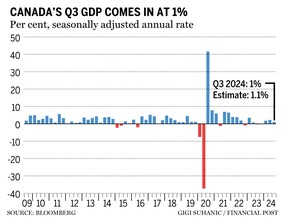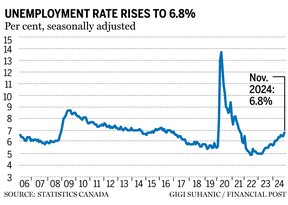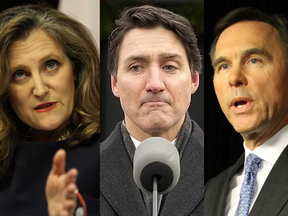The real measuring stick of a country’s economy is real GDP per capita
Article content
Canada’s in a recession and has been for quite some time, says economist Lars Osberg.
Article content
Article content
Perhaps not a true recession, according to the standard definition that requires two consecutive quarters of negative gross domestic product (GDP) growth, the professor at Dalhousie University said. The Canadian economy in the second quarter grew above forecasts at 2.1 per cent, before dropping to one per cent in the third quarter.
Advertisement 2
Article content
But Osberg said a recession is where we’d be if not for the country’s historic population growth. Canada in 2023 recorded its fastest population boom in 66 years, increasing by 1.3 million people, or 3.2 per cent, the vast majority of which came from immigration.
All those new residents are buying the basics in life and boosting consumption by enough to mask a struggling economy, he said.
“When you have population growth at three per cent a year, that’s a lot of people who are adding to aggregate demand,” he said.

The real measuring stick of a country’s economy, Osberg said, is real GDP per capita, an economy’s production per person. Canada’s real GDP per capita in the third quarter declined for the sixth consecutive quarter, falling by 0.4 per cent.
The unemployment rate in November rose to 6.8 per cent, up one percentage point from the same time last year.
“In terms of GDP per capita, we’ve been in a recession for some time now and the increase in the unemployment rate reflects that,” Osberg said.
He’s not the only one sounding the alarm bells.
Former Bank of Canada governor Stephen Poloz in December said Canada is in a recession. Like Osberg, he said the economy’s weakness has been masked by strong population growth.
Article content
Advertisement 3
Article content
Poloz said consumers have suffered a 30 per cent increase in the cost of living following the recent inflationary period, which has led to reduced spending. Inflation has also fallen faster than predicted, which he said only happens during a recession.
Economist David Rosenberg recently pointed out that Canada’s economy would have been in the hole last year without government stimulus.
“The government sector bailed out the national economy in Q3 with a huge 4.8 per cent annualized spending expansion,” he said in his Early Morning with Dave newsletter last month. “Strip that out, and real GDP declined at a 0.3 per cent annual rate. Not a good look.”
Rosenberg also highlighted the country’s sixth consecutive slide in real GDP per capita.

“Only one other time in recorded history has Canada’s real GDP per capita decayed sequentially for six quarters, and it was during the 1981-82 recession — this measure has also been negative in eight out of the last nine quarters. Real per capita GDP is now down 1.4 per cent on a year-over-year basis and lower than it was in the spring of 2017,” he said.
Advertisement 4
Article content
Osberg said the result is that the Bank of Canada needs to continue cutting interest rates. In 2024, the central bank cut its policy rate five times to reach 3.25 per cent. But he said any impacts from those cuts won’t be felt for a while.
“You’re talking about an 18-month lag from a change in interest rate to the full impact on the economy,” he said. “Interest rates went up pretty dramatically. They’re coming down, but we’re still going to bear the impact of that increase in interest rates for some time to come.”
Theoretically, lower interest rates entice investment and bolster productivity. But United States president-elect Donald Trump‘s threat to slap a 25 per cent tariff on all Canadian imports remains a source of uncertainty for Canada’s growth and investment.
That includes investment in fixed capital, such as manufacturing, which improves productivity, Osberg said.
“That uncertainty is likely to dominate the impacts of a decline in interest rates for the business sector,” he said. “At least until we can see which way the dust settles.”
A 25 per cent tariff could be particularly damaging for certain provinces, including Alberta and Saskatchewan, which export billions of dollars of oil and gas annually to the U.S.
Advertisement 5
Article content
Osberg said the U.S. has other options to secure its oil and gas supply if Trump implements his tariffs. Alberta’s oil and gas sector accounted for 82 per cent, or $127 billion, of the province’s exports to the U.S. in 2023.
“Alberta and Saskatchewan don’t have the same luxury,” he said. “So much of their potential revenue is dependent on the oil and gas sector and they don’t really have an alternative market for their product.”
Osberg also took aim at the current GST/HST tax holiday introduced by the federal government as a way to stimulate consumer spending. The economy needs fiscal stimulus, but he said there are myriad better ways it can be done while helping people on the bottom economic rungs.
Recommended from Editorial
-

RBC predicts slower growth over next few years
-

The working year that was: 2024
“It’s not just about stimulating the aggregate economy and the aggregate GDP,” he said. “It’s also about mitigating the hardship of some of those 6.8 per cent unemployed. They’re people too; they should count.”
• Email: arankin@postmedia.com
Bookmark our website and support our journalism: Don’t miss the business news you need to know — add financialpost.com to your bookmarks and sign up for our newsletters here.
Article content
Canada stuck in recession, say economists
2025-01-06 15:31:14







